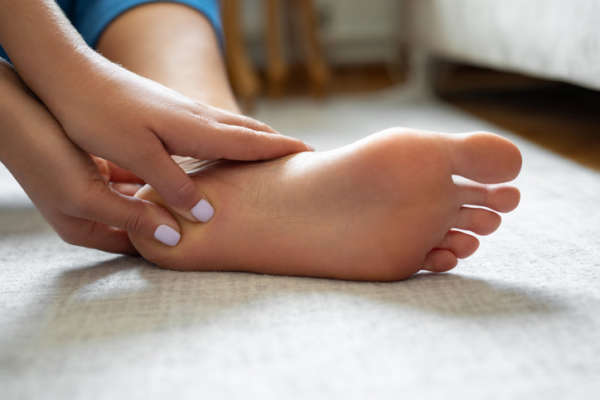
Plantar fasciitis is estimated to affect 10% of people over the course of their life. Symptoms are typically sharp, stabbing pain in the sole of the foot or heel when pressure is applied, or when standing after periods of rest. Most cases improve with relatively conservative treatment, including home remedies such as stretching, rest and massage. But when these approaches don’t work, diagnostic imaging and outside therapies may be recommended. Plantar fasciitis is most common in runners, people who are overweight, in occupations requiring prolonged standing or walking and those with foot alignment issues or who have one leg longer than the other.
Plantar fasciitis is defined as an inflammation of the plantar fascia – the sheath or band of tissue that extends through the medial longitudinal arch of the foot. The plantar fascia almost entirely covers the plantar (sole) surface of the feet. This important structure provides static support for the longitudinal arch of the foot. It also acts as a shock absorber through its limited ability to elongate.
From an East Asian Medicine (EAM) perspective, when we address plantar fasciitis, we are moving qi and strengthening the Liver energetic system, which is in charge our fascia, tendons and ligaments. We are also strengthening the Kidney energetic system, which is in charge of our lower legs, ankles and feet.
Acupuncture improves plantar heel pain through several pathways. One way is that the insertion of needles causes a local effect on nerve endings, releasing neuropeptides that help eliminate pain. There is also some excellent research showing that a substance called adenosine is released during acupuncture treatments and has a potent pain-relieving and anti-inflammatory effect, as well as promoting blood flow to the area. Other local cells, known as fibroblasts, are stimulated by acupuncture promoting tissue healing in the area.
Research has also demonstrated that the body releases its own opioids, the body’s natural ‘pain killer,’ during acupuncture treatments. Studies that look at changes in brain activity during acupuncture, show that following a treatment, there is less activity in brain regions associated with pain perception and increased activity in areas that regulate our response to pain.
Massage or gua sha can also be very helpful for dealing with plantar fasciitis pain. Getting a professional foot massage or performing gua sha on the sole of your foot can change things tremendously.
Moxibustion is another modality of East Asian Medicine that can provide relief to plantar fasciitis pain. Moxibustion uses an herb known as mugwort that improves circulation, which oxygenates the tissues, allowing them to heal more quickly. The combination of acupuncture and moxibustion is a great way to treat plantar fasciitis.
Regular stretching is another way to keep your heel pain at bay. Here are some easy stretches that you can do almost anywhere:
- Calf stretch: Start by putting your hands on a wall or tree. Take one foot back. You want the heel that is painful to be completely down and your front knee to be bent. If you don’t feel the calf stretch, slightly bend the back knee. If you feel any pain in your Achilles tendon, walk your back leg forward for a more gentle stretch.
- Shins: Put your back against the wall and move about two inches away from it. Flex your feet, activating your shins. Rather than squeezing your glutes, squeeze your shins to pull yourself to a standing position. Flex your feet and lean back against the wall. Again, focus on using your shins.
- Do the alphabet with your ankle: This returns your foot to its proper function from being in shoes that pulled your heel down.
- Roll out your calves with a foam roller (if comfortable). You do not roll out your feet with plantar fasciitis: it’s like little micro tears in the bottom of your feet and a tennis ball or foam roller will make it worse.
If you or someone you know is suffering with plantar fasciitis, contact us. East Asian Medicine is a great way to keep that pesky heel pain at bay and get you back out there enjoying life.

